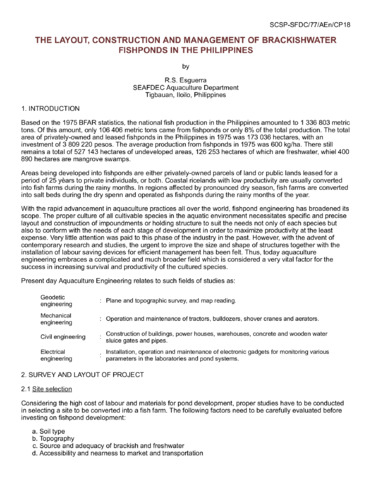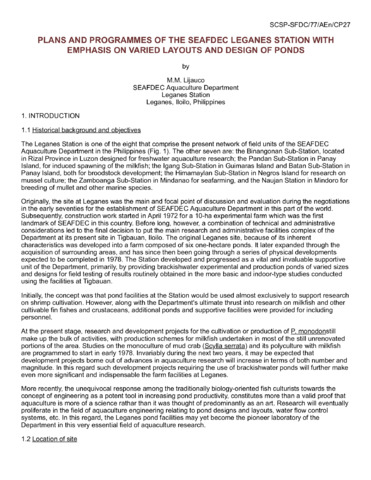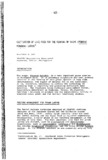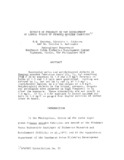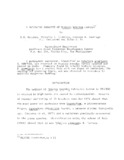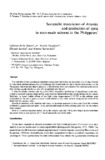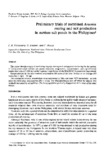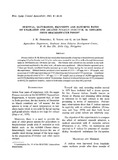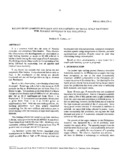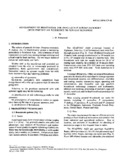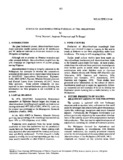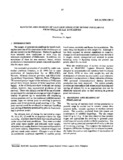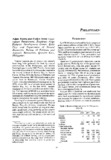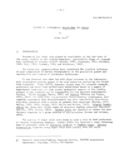Browsing AQD Conference Proceedings by Issue Date
Now showing items 1-20 of 298
-
A preliminary report on the fauna of decapod crustacea in the mangrove and estuarine areas of Batan Bay, Panay Island, Philippines
(Los Baños, Laguna, Philippines: Philippine Council for Agricultural and Resources Research, 1977)In the Philippines, the total mangrove site for aquaculture development and others is about 576,000 hectares which constitute only 1.9 percent of the country's land resources. There are at present about 176,000 hectares ... -
The layout, construction and management of brackishwater fishponds in the Philippines
(South China Sea Fisheries Development and Coordinating Programme, 1977)With the advent of new research and studies into aquaculture practices there is a need to improve the size and shape of brackishwater ponds in the Philippines and to make their management more efficient. This article ... -
Engineering aspects and problems in the design and construction of fishpens and fish cages in Laguna Lake, Philippines
(South China Sea Fisheries Development and Coordinating Programme, 1977)The profitability of the fishpen industry in Laguna de Bay cannot be over-emphasized. However, a good engineering design must be prepared, in addition to the feasibility study in production and marketing. The destructive ... -
Plans and programmes of the SEAFDEC Leganes Station with emphasis on varied layouts and design of ponds
(South China Sea Fisheries Development and Coordinating Programme, 1977)As the importance of engineering to aquaculture becomes more apparent it is also realized that the physical properties of a pond have a strong influence on its productivity. This article reports the plans and programmes ... -
Cultivation of live feed for the rearing of sugpo (Penaeus monodon) larvae
(European Mariculture Society, 1979)The sugpo, Penaeus monodon, is a very important prawn species in Southeast Asia. It is extremely euryhaline and fast growing. Interest in the farming of this prawn species is very high. Unfortunately, the supply of natural ... -
Effects of furanace on the development of larval stages of Penaeus monodon Fabricius
(Sea Grant College Program, Texas A&M University, 1979)Successful molts and morphological defects in P. monodon zoeae (Z1, Z2, Z3) resulting from a 24-h exposure to 1.0 and 2.0 mg/L furanace in baths of 1.0 and 2.0 mg/L were quantified. Molting ... -
Supplemental feeding of Tilapia mossambica
(Heenemann Verlagsgesellschaft, 1979)T. mossambica were grown to marketable size in floating cages in Laguna de Bay at a stocking density of 75/m2. Those given supplemental feed 1 (rice bran:ipil-ipil:fish meal, 60:20:20) showed significantly faster ... -
A suctorean parasite of Penaeus monodon larvae
(Sea Grant College Program, Texas A&M University, 1979)A pathogenic suctorean, identified as Ephelota gemmipara was observed in P. monodon larvae spawned and reared in tanks. Commonly found to inhabit hydroid colonies, E. gemmipara has a stalked body with two types of tentacles, ... -
Successful inoculation of Artemia and production of cysts in man-made salterns in the Philippines
(Universa Press, 1980)The objective of the inoculation described in this paper was to test the feasibility of culturing Artemia in man-made earthen salterns and of producing adults and cysts for use in aquaculture projects in the Philippines. ... -
Preliminary trials of combined Artemia rearing and salt production in earthen salt ponds in the Philippines
(Universa Press, 1980)This paper describes trials at combining Artemia rearing with salt production during the dry season, in newly-constructed earthen salt ponds (reservoir, evaporation, concentration, and crystallization ponds, total area of ... -
Status of Macrobrachium research at Binangonan Research Station (SEAFDEC, Philippines)
(Elsevier Scientific Publishing Company, 1982)The freshwater prawn Macrobrachium abounds in the rivers, lakes and estuaries of the Philippines. At SEAFDEC, Binangonan Research Station, a few preliminary studies have been conducted on Macrobrachium sp. and M. rosenbergii ... -
Survival, maturation, fecundity and hatching rates of unablated and ablated Penaeus indicus H.M. Edwards from brackishwater ponds
(The Marine Biological Association of India, 1982)Penaeus indicus H. M. Edwards harvested after three months of rearing in brackishwater ponds and averaging 6.9 g for females and 5.6 g for males were stocked in two 12 cu m flowthrough ferrocement tanks at 240 females and ... -
Studies on broodstock of sugpo Penaeus monodon Fabricius and other penaeids at the SEAFDEC Aquaculture Department
(Cochin, India: The Marine Biological Association of India, 1982)For hatchery production of Penaeus monodon and other penaeid fry, the SEAFDEC Aquaculture Department is dependent mainly on captive broodstock in the form of ablated females, using up to 1,500 spawners in one year. The ... -
Recent developments in design and management of small-scale hatchery for Penaeus monodon in the Philippines
(South China Sea Fisheries Development and Coordinating Programme, 1982)It is a common belief that the zoea of Penaeus monodon are completely filter feeders. Thus, diatoms like chaetoceros and phytoflagellates are maintained at high feeding densities as much as 80 000 cells/ml in hatchery tanks ... -
Development of broodstock for small-scale shrimp hatchery (with particular reference to Penaeus monodon)
(South China Sea Fisheries Development and Coordinating Programme, 1982)To be self-sufficient in spawner/larval supply, a small-scale Penaeus monodon hatchery should have the following: 1) broodstock tanks or pens depending on location and other factors; 2) pond sources of broodstock of ... -
Status of Macrobrachium farming in the Philippines
(South China Sea Fisheries Development and Coordinating Programme, 1982)Research on larval rearing of Macrobrachium is reviewed. The future of prawn culture is discussed. -
Handling and rearing of hatchery-produced shrimp postlarvae from small-scale hatchery
(South China Sea Fisheries Development and Coordinating Programme, 1982)This paper discusses the handling and rearing of hatchery-produced Penaeus post larvae. The survival and growth of hatchery produced fry and wild caught fry are discussed. -
Country report: Philippines
(International Development Research Centre, 1982)Natural populations of oysters and mussels have long been gathered for food by coastal communities in the Philippines, and bivalve farming began in early 1900. The first farms were no more than a series of bamboo poles ... -
Biology, use and culture of Artemia
(South China Sea Fisheries Development and Coordinating Programme, 1982) -
Culture of zooplankton (Brachionus and Moina)
(South China Sea Fisheries Development and Coordinating Programme, 1982)


